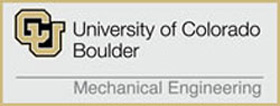Front Page
Mondays: HUMAN 505 (Eaton Humanities north west of Norlin) 4PM-5:15PM
Wednesdays: ECCR 131 (along SW corridor in the Engineering Center) 4PM-5:15PM
Course Description
This course teaches how to visualize, and then model the displacements and moving of atoms (or molecules), by themselves or in clusters, to predict mechanical behavior of crystalline materials. Four kinds of properties:
(i) Elastic deformation
(ii) Plastic deformation
(iii) Fracture, and
(iv) High temperature behavior, will be covered.
The models serve to link length scales in the mechanical behavior of materials. Events on the atom-scale must be linked to experiments carried out in the laboratory with physical specimens, and finally the properties measured in the laboratory must be used to design engineering devices. The devices can be huge, like an aeroplane, or miniature like the atomic force microscope. State of the art optical fibers and Gorilla glass are also examples of materials that have revolutionized the way we live.
In all instances the links between length scales would be quantitative that can be modeled and used for prediction of mechanical performance.
Books
It is difficult to specify one book because the field is very interdisciplinary. Every author (including me) thinks differently, and has a different emotional relationship to the subject
I would recommend that you buy the following book, which has been around for a long time and my still be available at Amazon. It is written in the same spirit as is this course.
(i) The following book is available on amazon.com/books, in hard cover and paperback versions.
The Mechanical Properties of Matter: Alan H. Cottrell, 1964, Wiley
(ii) Another book is by George Dieter is related to engineering aspects of mechanical properties
Mechanical Metallurgy, 3rd Edition
Mechanical Metallurgy, 1st Edition
I will supplement the lectures with handouts.
HomeWork and Grading
I will set practice HW problems (to be posted online). These will not be graded. You are encouraged to work with friends to address these problems. I am available to answer questions both in my office and during class
A Take Home exam will be give out after each of the four topics, elasticity, plasticity, fracture and high temperature, at intervals of three to four weeks.
Each of the four take home exams will count for 20% of the grade, with the remaining 20% reserved for the paper and the presentation
